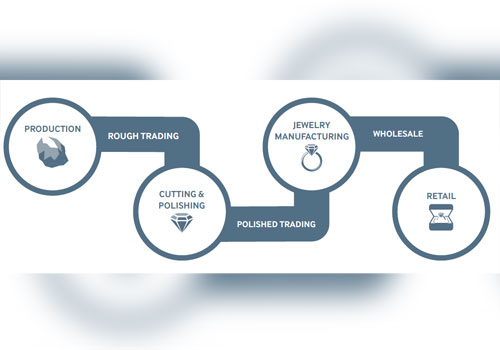Myanmar: Clear mandate and management structure essential for MGE
The Natural Resource Governance Institute has published a report Governing the Gemstone Sector: Lessons from Global Experience in which Myanmar’s state-owned enterprise is featured as a case study.
The report considers how countries may improve management of their gemstone resources, offers lessons from international experience and recommends policy options for governments interested in enhancing their sector’s governance. It names four key issues affecting the sector globally: widespread illegal activity, low revenue collection, minimal value addition and weak oversight.
According to the figures, Myanmar is unable to retain most of the beneficiation of its gemstones.
The process in which rough gemstones are transformed into finished jewellery products consists of several discrete steps: production, cutting and polishing, jewellery manufacturing, and retail.
“The value chain tends to be geographically fragmented; most gemstones pass through multiple jurisdictions between when they are extracted and eventually marketed to consumers,” the report stated.
In terms of production, the vast majority of the world’s high-quality jadeite is mined in Kachin State, although significant volumes of Canadian nephrite are also being marketed as jade. In contrast, for beneficiation (in this context, cutting and polishing), the overwhelming majority of these value-added processing takes place in China, not Myanmar.
Additionally, the jade sector in Myanmar is made into a case study for modernising state-owned enterprises (SOEs). The report indicated that Myanmar’s gemstone state-owned enterprise has taken an active part in the sector.
“Globally significant joint ventures for coloured gemstones with state involvement include … the more than 300 projects between the Myanmar Gems Enterprise [MGE] and private companies [jade and other coloured gemstones],” it explained.
Among the issues, Governing the Gemstone Sector: Lessons from Global Experience said the MGE’s responsibilities pose a conflict of interest and are poorly defined.
“[The MGE’s] vague role, lack of capacity, and clear conflicts of interest have created opportunities for mismanagement and rent-seeking.
“The mandate, responsibilities and management structure of MGE are not articulated in law,” the report noted.
According to Emma Irwin’s Myanmar EITI Gemstone Sector Review and NRGI’s report Gilded Gatekeepers: Myanmar’s State-owned Oil, Gas and Mining Enterprises co-authored by Patrick RP Heller and Lorenzo Delesgues, the MGE has historically acted with “an exceptional degree of autonomy”, though the organisation is officially accountable to the Ministry of Natural Resources and Environmental Conservation (MoNREC). Additionally, the MGE lacks a board of directors.
Laws and regulations related to the sector do not specify how the MGE should collaborate or work with other agencies which govern the gemstone sector, such as the Department of Mines and the Central Gemstone Supervisory Committee. The case study also described the Central Gemstone Supervisory Committee has “an equally nebulous body”. The committee serves as the official valuation authority and tenders advice to the MoNREC regarding designation of gemstone tracts, licensing, taxation and setting of royalty rates.
In practice, the MGE has exercised extensive authority over the gemstone sector. The report said that its authorities include oversight of the licensing process, which is managed by the Department of Mines, geological data, which is handled by the Department of Geological Survey, and environmental management, operated by the Environmental Conservation Department.
“However, in the absence of adequate budget and expertise, some of these duties have been poorly executed or neglected altogether.
“[The] MGE is only capacitated to monitor production for a fraction of operations — more than 21,000 active gemstone mining licenses were reported as of April 2016 — and enforcement of environmental and safety standards remains largely absent,” it argued.
Another issue is that the MGE’s commercial involvement in joint ventures conflict with its regulatory powers.
“MGE’s leadership is largely composed of former military personnel, while the Myanmar armed forces maintain significant business interests in the gemstone sector,” it said, adding that some amendments to the Myanmar Gemstone Law in 2016 exacerbated these conflicts of interest.
Amendments to that piece of legislation assigned three seats on the Central Gemstone Supervisory Committee to the Myanmar Gem and Jewellery Entrepreneurs Association (MGJEA), an industry group.
The report added that the success of the new NLD-led government’s reform efforts would hinge, in part, on whether and how the MGE’s position and responsibilities in the sector is addressed.
The authors noted that SOEs should be structured in a manner which encourages the efficient allocation of resources, incentivises strict adherence to a clearly defined mandate, and reinforces transparency and accountability.
The case study of the MGE and other examples suggest that governments may support effective engagement by SOEs in the gemstone sector by revisiting roles and responsibilities of SOEs, eliminating conflicts of interest and investing in professionalisation. They should not allow any conflicting mandates between the commercial involvement and regulatory responsibilities of the enterprises.
“Regardless of the scope of SOE responsibilities, it is imperative that laws clearly define the objectives of and limitations on enterprises’ authority.
“In keeping with the principle that citizens are SOEs’ ultimate shareholders, company activities and finances should be externally reviewed and made publicly available.
“Setting minimum requirements in terms of education and experience for board members or senior management, for example, may support informed decision-making based on technical criteria,” it explained.
“Myanmar is one of the world’s leading producers of coloured gemstones, but lags behind many other countries in implementing a coherent, effective, and transparent system for governing the sector,” Paul Shortell, associate at the NRGI, told The Myanmar Times.
Source: http://www.mmtimes.com/index.php/business/26393-clear-mandate-and-management-structure-essential-for-mge.html


 English
English




